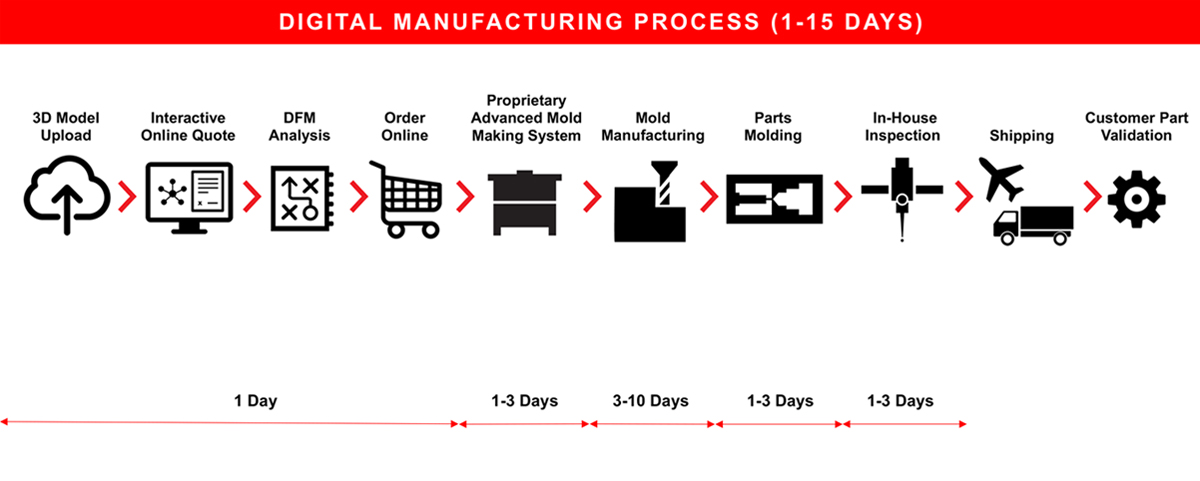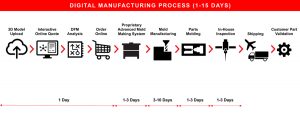
This content has been updated. Please visit the new post about digital manufacutring.
What is digital manufacturing?
Rapid or digital manufacturing is a natural progression from traditional manufacturing. The capabilities afforded by digitization, automation and data connectivity translate into reduced costs and increased efficiencies.
So how does it work? Each process step is streamlined to accommodate quicker turnaround times with low-cost automated solutions.

Digital Manufacturing Process
The process is entirely digitized and starts with the upload of a 3D CAD file onto our servers. Within a very short timeframe, the geometry and requirements are analyzed, thanks to proprietary software, and an interactive quote becomes available online. Upon approval an order is generated and the mold design is finalized within hours – together with the toolpath programming. Using modular construction and standardized components, mold components are then machined, usually within a few days. After benching and mold finishing, the tool is assembled for first shots and inspection.
This process, achieved through rapid molding, will give your part a lead time of weeks instead of months. The average price? A fraction of the cost for traditional molding. The capacity that’s available for you to get your part made? Your lead time is always the priority. It’s made in the USA with as many sourced mold materials and resins that can be procured in the allotted time.
As a result, digital manufacturing naturally accelerates every step of the process and reduces the labor intensity while driving the scale of your project. A great example might be a state-of-the-art syringe. It may consist of three, distinct injection-molded parts. Before new production runs are needed to meet supply and demand, the product manager may have a revision to one of the components, driven by departmental standards. In traditional manufacturing, the retooling investment may push the break- even manufacturing numbers into the thousands – a cost-prohibitive change for many smaller businesses. Digital manufacturing, in comparison, can implement that small design change for approximately a quarter of the investment in a quarter of the time.
That is why our unique ability to accommodate complex designs is our asset. Your designers have fewer roadblocks, freeing them to work on new projects instead of going back to the drawing board to modify their designs so they can be produced. Rapid results let your team respond quickly to market requirements with the best product they can design – a competitive edge that keeps your company on- top. Without design rework or months-long lead times, innovation can boost your company’s results.
The digital manufacturing process at Xcentric Mold & Engineering is a very rapid and seamless process. The key components of this process include cost, quality, automation and speed to market, which allows customers to go through the iteration process once or numerous times, if necessary, at a very quick speed. By following these steps, customers can maintain their existing quality controls, while developing good parts getting them to market faster.
There are two optional services in this process, inspection and project management consulting. After molding the parts, the in-house inspection allows the customer and us to determine the quality of the product and discover errors immediately. Digital inspection allows for rapid feedback and tool modifications, if necessary. Experienced Tooling Engineers interface directly with designers during the entire process, providing expert advice and problem solving at any time, which is critical to ensure successful and fast product manufacturing.
In fact, shorter lead times from concept to development can create new-market discoveries. Previously untapped revenue streams that were potentially out of reach can be viable, thanks to new technologies, transforming how companies like yours do business. Low-cost tooling, development and production have been streamlined so low-production runs are economical enough to test on select markets and use the feedback as an optimized learning curve. Should demand rapidly increase, the rapid manufacturing process can transition between low-volume to mass production. In turn, that allows you to react to market behaviors quickly and easily, reduce your time to market for increased competitiveness and resolve any potential problems before they impact your shipments. In instances where production inadvertently slows, rapid manufacturing allows you to make adjustments while still achieving the lowest total cost. That means regardless of the market’s volatility, rapid manufacturing lets you respond accordingly.
Mold Considerations
There’s more to the process than lower cost and production times, however. The quality of your part is critical, and the tool must be available over the whole lifecycle of your project. This is made possible by the high-grade aluminum base material we use, in particular QC-10, which offers an excellent strength- to-weight ratio. Compared to steel, aluminum is softer and less dense, dissipates heat quickly and efficiently and costs up to 75% less. It’s also an indefinitely recyclable material, a large consideration when utilizing a subtractive manufacturing process, where material waste can be higher than 50% per part. Recyclability and material reuse can help recoup initial material costs.
Although aluminum may not be the right material for every type of mold, it works particularly well for prototyping, bridge tooling and low volume production. Depending on the size and structure of the parts being made, the heat dissipation within an aluminum mold can be up to 50% higher than steel or other metals, creating faster production turnaround times. The primary disadvantage is that, over time, aluminum molds can break down from repeated use: using the same mold for millions of parts may cause its structural integrity to break down and the profile of details to blur; however, running thousands of parts using aluminum molds can provide a tremendous cost savings as well as reduce production times. Xcentric offers a Lifetime Mold Guarantee so mold break-down shouldn’t be a detriment.
As you can see, the capabilities of rapid manufacturing is varied and robust with two major caveats: They take less time and cost less to produce. Digital manufacturing offers a plethora of benefits across multiple touchpoints: reducing your time to market, labor overhead and asset utilization, giving you more opportunities for quality control and inventory management. These advantages allow you to explore new revenue streams, develop and enhance innovative designs and respond to market demands. The digital age can transform your company and give your designers the freedom they need to create, develop and enhance in one streamlined methodology. The future is here. Make it work for you.
Do you have any questions regarding the digital manufacturing process? Contact one of our Technical Specialists at 586-598-4636 or sales@xcentricmold.com. We will be happy to review your design and provide you with recommendations.